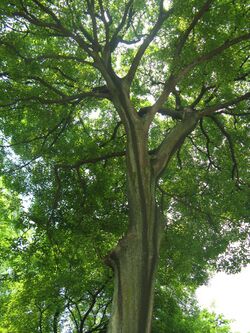Biology:Celtis sinensis
| Chinese hackberry | |
|---|---|

| |
| Mature tree at Yuelu Academy | |
| Scientific classification | |
| Kingdom: | Plantae |
| Clade: | Tracheophytes |
| Clade: | Angiosperms |
| Clade: | Eudicots |
| Clade: | Rosids |
| Order: | Rosales |
| Family: | Cannabaceae |
| Genus: | Celtis |
| Species: | C. sinensis
|
| Binomial name | |
| Celtis sinensis Pers.[1]
| |
| Synonyms | |
| |
Celtis sinensis (English: Japanese hackberry,[2] Chinese hackberry; Chinese: 朴树 ; Japanese: 榎) is a species of flowering plant in the hemp family, Cannabaceae, that is native to slopes in East Asia.[3]
Description
It is a tree that grows to 20 m tall, with deciduous leaves and gray bark. The fruit is a globose drupe, 5–7(–8) mm in diameter. Flowering occurs in March–April, and fruiting in September–October,[3] in the Northern hemisphere.
Distribution, habitat and uses
Native to slopes at altitudes of 100–1500 m in Anhui, Fujian, Gansu, Guangdong, Guizhou, Henan, Jiangsu, Jiangxi, Shandong, Zhejiang, Sichuan , as well as Korea (팽나무),[3] Japan and Taiwan. Leaves and bark are used in Korean medicine to treat menstruation and lung abscess.[4] It is a naturalized non-invasive species in North America. It is a declared noxious weed in many parts of eastern Australia,[5][2] where its seeds are spread by birds, fruit bats and water in riparian zones, roadsides, urban bushland, open woodlands, rainforest margins, waste areas, disturbed sites, parks and gardens, in sub-tropical and warm temperate regions.[5]
As an ornamental plant, it is used in classical East Asian garden design.
Celtis sinensis bonsai at the Parc floral de Paris
See also
- Great purple emperor
References
| Wikimedia Commons has media related to Celtis sinensis. |
- ↑ {{citation | mode = cs1 | title = Celtis sinensis | work = Germplasm Resources Information Network (GRIN) | url = | publisher = [[Organization:Agricultural Research ServAgricultural Research Service (ARS), United States Department of Agriculture (USDA) | access-date = 2010-02-21 }}
- ↑ 2.0 2.1 G. J. Harden (1999). "Celtis sinensis Pers.". Royal Botanic Garden, Sydney. https://plantnet.rbgsyd.nsw.gov.au/cgi-bin/NSWfl.pl?page=nswfl&lvl=sp&name=Celtis~sinensis.
- ↑ 3.0 3.1 3.2 eFloras, Missouri Botanical Garden & Harvard University Herbaria, Celtis sinensis, FOC Vol. 5, Page 18, http://efloras.org/florataxon.aspx?flora_id=2&taxon_id=200006313, retrieved October 29, 2009
- ↑ Park, Kwang woo. 《반응표면분석법을 이용한 팽나무 (Celtis sinensis Persoon) 의 최적 변색제거조건 결정》한국인간ㆍ식물ㆍ환경학회지, Vol.1 No.2| p. 74-84 Accessed in 2013-10-8
- ↑ 5.0 5.1 "Celtis chinensis". https://profiles.ala.org.au/opus/weeds-australia/profile/Celtis%20sinensis.
Wikidata ☰ Q706339 entry
 |







